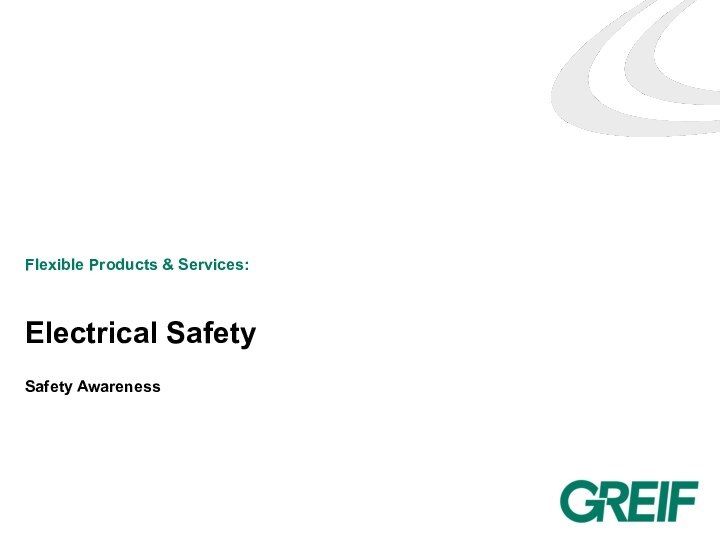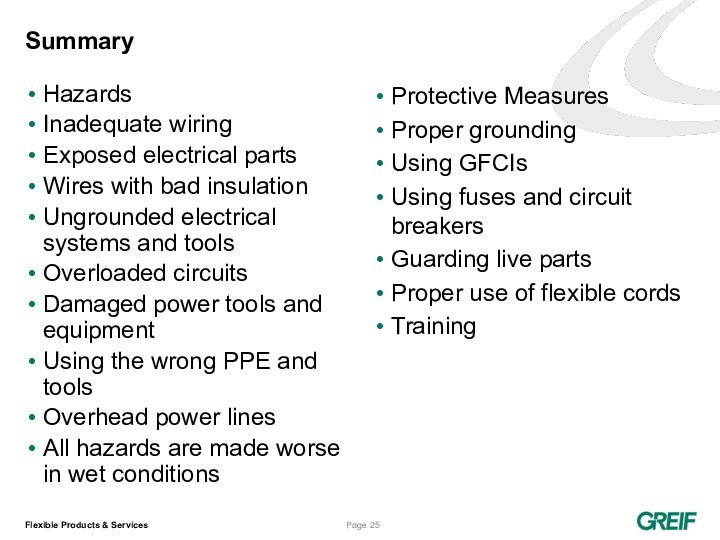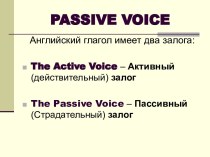- Главная
- Разное
- Бизнес и предпринимательство
- Образование
- Развлечения
- Государство
- Спорт
- Графика
- Культурология
- Еда и кулинария
- Лингвистика
- Религиоведение
- Черчение
- Физкультура
- ИЗО
- Психология
- Социология
- Английский язык
- Астрономия
- Алгебра
- Биология
- География
- Геометрия
- Детские презентации
- Информатика
- История
- Литература
- Маркетинг
- Математика
- Медицина
- Менеджмент
- Музыка
- МХК
- Немецкий язык
- ОБЖ
- Обществознание
- Окружающий мир
- Педагогика
- Русский язык
- Технология
- Физика
- Философия
- Химия
- Шаблоны, картинки для презентаций
- Экология
- Экономика
- Юриспруденция
Что такое findslide.org?
FindSlide.org - это сайт презентаций, докладов, шаблонов в формате PowerPoint.
Обратная связь
Email: Нажмите что бы посмотреть
Презентация на тему Electrical safety
Содержание
- 2. There are four main types of electrical injuries:Electrocution (death due to electrical shock)Electrical shockBurnsFallsIntroduction
- 3. General Requirements for Electrical EquipmentExamination – free
- 4. Training RequirementsApplies to:Supervisors*, electricians, machine operators*, painters*,
- 5. Electrical TerminologyCurrent – the movement of electrical
- 6. Working on or near exposed electrical partsDon’t
- 7. Electrical ShockReceived when current passes through the
- 8. Electrical BurnsMost common shock-related, nonfatal injuryOccurs when
- 9. FallsElectric shock can also cause indirect or
- 10. Inadequate wiring hazardA hazard exists when a
- 11. Overload hazardsIf too many devices are plugged
- 12. Electrical Protective DevicesThese devices shut off electricity
- 13. Guarding of Live partsMust enclose or guard
- 14. Cabinets, Boxes and FittingsJunction boxes, pull boxes
- 15. Thermal imaging
- 16. Use of Flexible CordsMore vulnerable than fixed
- 17. Permissible Uses of Flexible Cords - examplesPendant, orFixture WiringPortable lamps,tools or appliancesStationary equipment-to facilitate interchange
- 18. Prohibited Uses of Flexible cords - examplesSubstitute
- 19. Procedures for using Portable AppliancesProper handling of
- 20. Procedures for using Portable AppliancesEquipment inspectionVisually check
- 21. Procedures for using Portable AppliancesEquipment inspectionRemove defective
- 22. Procedures for using Portable AppliancesPlugging/unplugging cord
- 23. Use of Nonconductive LaddersPortable ladders must
- 24. Clues that Electrical Hazards ExistTripped circuit breakers
- 25. Скачать презентацию
- 26. Похожие презентации
There are four main types of electrical injuries:Electrocution (death due to electrical shock)Electrical shockBurnsFallsIntroduction

























Слайд 2
There are four main types of electrical injuries:
Electrocution
(death due to electrical shock)
Слайд 3
General Requirements for Electrical Equipment
Examination – free from
recognized hazards
Installation – in accordance with labeling
Marking – manufacturer’s
name, voltage, current, wattageDisconnect switches- labeled to indicate the circuit’s function
Working clearances in front of electrical equipment
Guarding of live parts operating at 50 volts or more
Cabinets, secured rooms – proper labeling
Must also protect from physical damage (forklifts)
Слайд 4
Training Requirements
Applies to:
Supervisors*, electricians, machine operators*, painters*, engineers*,
and welders
(*) Do not have to be trained if
they do not work close to exposed partsRequirements depend on job tasks:
PPE, installation, safe clearances, skills to distinguish exposed parts, determine voltage
Слайд 5
Electrical Terminology
Current – the movement of electrical charge
Resistance
– opposition to current flow
Voltage – a measure of
electrical forceConductors – substances, such as metals, that have little resistance to electricity
Insulators – substances, such as wood, rubber, glass, and bakelite, that have high resistance to electricity
Слайд 6
Working on or near exposed electrical parts
Don’t work
on or near exposed electrical parts unless:
The part is
de-energizedThe part is locked/tagged out
Слайд 7
Electrical Shock
Received when current passes through the body
Severity
of the shock depends on:
Path of current through the
bodyAmount of current flowing through the body
Length of time the body is in the circuit
Low voltage does not mean low hazard
Слайд 8
Electrical Burns
Most common shock-related, nonfatal injury
Occurs when you
touch electrical wiring or equipment that is improperly used
or maintainedTypically occurs on the hands
Very serious injury that needs immediate attention
Слайд 9
Falls
Electric shock can also cause indirect or secondary
injuries
Workers in elevated locations who experience a shock
can fall, resulting in serious injury or death
Слайд 10
Inadequate wiring hazard
A hazard exists when a conductor
is too small to safely carry the current
Example:
using a portable tool with an extension cord that has a wire too small for the toolThe tool will draw more current than the cord can handle, causing overheating and a possible fire without tripping the circuit breaker
The circuit breaker could be the right size for the circuit but not for the smaller-wire extension cord
Слайд 11
Overload hazards
If too many devices are plugged into
a circuit, the current will heat the wires to
a very high temperature, which may cause a fireIf the wire insulation melts, arcing may occur and cause a fire in the area where the overload exists, even inside a wall
Слайд 12
Electrical Protective Devices
These devices shut off electricity flow
in the event of an overload or ground-fault in
the circuitInclude fuses, circuit breakers, and ground-fault circuit-interrupters (GFCIs)
Fuses and circuit breakers are overcurrent devices
When there is too much current:
Fuses melt
Circuit breakers trip open
Слайд 13
Guarding of Live parts
Must enclose or guard electric
equipment in locations where it would be exposed to
physical damage
Слайд 14
Cabinets, Boxes and Fittings
Junction boxes, pull boxes and
fittings must have approved covers
Unused openings in cabinets, boxes
and fittings must be closed (no missing knockouts)
Слайд 16
Use of Flexible Cords
More vulnerable than fixed wiring
Flexible
cords can be damaged by:
Aging
Door or window edges
Staples or
fasteningsAbrasion from adjacent materials
Activities in the area
Improper use of flexible cords can cause shocks, burns or fire
Слайд 17
Permissible Uses of Flexible Cords - examples
Pendant, or
Fixture
Wiring
Portable lamps,
tools or appliances
Stationary equipment-to facilitate interchange
Слайд 18
Prohibited Uses of Flexible cords - examples
Substitute for
fixed wiring
Run through walls, ceilings, floors, doors, or windows
Concealed
behind or attached to building surfaces
Слайд 19
Procedures for using Portable Appliances
Proper handling of cords
Don’t
raise or lower equipment by its cord
Don’t unplug the
equipment by pulling on its cordDon’t staple or fasten the cord so as to damage the outer jacket
Слайд 20
Procedures for using Portable Appliances
Equipment inspection
Visually check for:
Loose
parts
Deformed or
missing parts
Damaged
jackets or
insulation
Слайд 21
Procedures for using Portable Appliances
Equipment inspection
Remove defective equipment
from service
Check the plug and receptacle mating configuration
before
connecting
Слайд 22
Procedures for using Portable Appliances
Plugging/unplugging
cord and cord-connected
equipment and flexible cords
Ensure hands are dry
Never pull the
plug
out by the cord
Слайд 23
Use of Nonconductive Ladders
Portable ladders must
have nonconductive
side rails when used
near energized parts
Metal ladders can
conduct electricity
and cause arcing and
shocks
Слайд 24
Clues that Electrical Hazards Exist
Tripped circuit breakers or
blown fuses
Warm tools, wires, cords, connections, or junction boxes
Ground
Fault Circuit Interrupter that shuts off a circuitWorn or frayed insulation around wire or connection
https://www.youtube.com/watch?v=vhtQGQbuq6w
https://www.youtube.com/watch?v=WNot2owIv8c





























